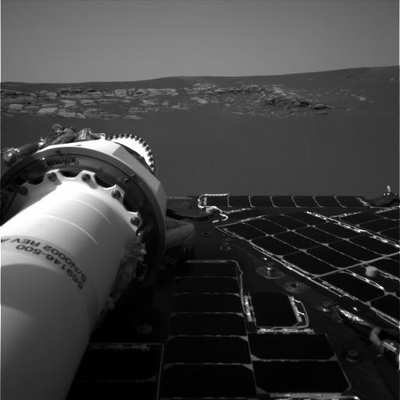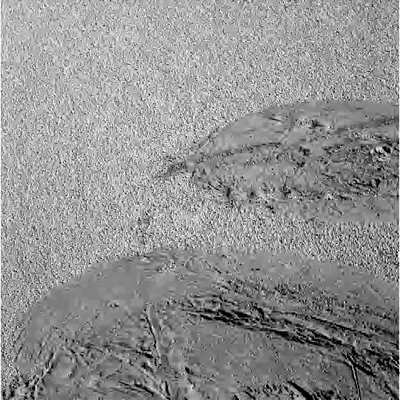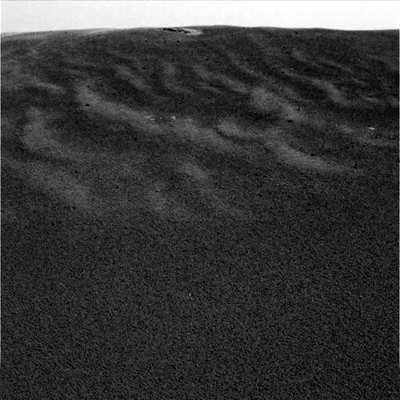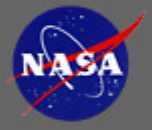Opportunity Knocks Yet Again
NASA's Mars rover Opportunity is closing in on what may be the
grandest overlook and richest science trove of its astonishingly
long mission.

During the next two weeks, the robotic geologist is likely to
reach the rim of a hole in the Martian surface wider and deeper
than any it has visited. The crater, known as "Victoria," is
approximately 750 meters (half a mile) wide and 70 meters (230
feet) deep.
Images from NASA's Mars Global Surveyor orbiter show the crater
walls expose a stack of rock layers approximately 30 to 40 meters
(100 to 130 feet) thick. Opportunity will send back its initial
view into the crater as soon as it gets to the rim. Scientists and
engineers will use Opportunity's observations from points around
the rim to plot the best route for entering the crater.

"Victoria has been our destination for more than half the
mission," said Ray Arvidson of Washington University in St. Louis,
MO. Arvidson is deputy principal investigator for Opportunity and
its twin rover, Spirit.
"Examination of the rocks exposed in the walls of the crater
will greatly increase our understanding of past conditions on Mars
and the role of water. In particular, we are very interested in
whether the rocks continue to show evidence for having been formed
in shallow lakes."
The NASA rovers have been exploring landscapes on opposite sides
of Mars since January 2003. Their prime missions lasted three
months. Both rovers are still investigating Mars' rocks, soils and
atmosphere after more than 30 months. Opportunity works in a region
where rock layers hundreds of meters or yards in thickness cover
older, heavily cratered terrain.

"We have a fully functional vehicle with all the instruments
working. We're ready to hit Victoria with everything we've got,"
said Byron Jones, a rover mission manager at NASA's Jet Propulsion
Laboratory, Pasadena, Calif.
Though it's still winter in Mars' southern hemisphere, days have
begun getting longer again -- and Opportunity's power supply from
its solar panels is increasing daily.
During its first two months on Mars, Opportunity examined a
30-centimeter (one-foot) stack of rock layers at its landing site
inside "Eagle Crater" and found geological evidence that water had
flowed across the surface long ago. The rover spent the next nine
months driving to and exploring a larger crater, "Endurance." There
it examined a stack of exposed layers 7 meters (23 feet) thick.
Over the drive from Endurance to Victoria, the rocks tell a history
of shallow lakes, drier periods of shifting dunes and groundwater
levels that rose and fell. Minerals indicate the ancient water was
very acidic.
The much thicker stack of revealed rock layers at Victoria
beckons.

"We want to examine the thick section of rocks exposed on the
walls in Victoria crater to understand whether the environment that
produced these materials was similar to the environment recorded in
the rocks that we have seen so far," said Arvidson. "Is there a
record of a different type of deposition? Was there a wet
environment that was less acidic, perhaps even more habitable?
Where do the layers from Endurance fit in this thicker
sequence?"
 NASA's Mars
Reconnaissance Orbiter reached Mars in March 2006. It will begin
its primary science phase in November, offering higher resolution
images and mineral mapping than have been possible with previous
orbiters. Victoria will be one target for the orbiter. "By
combining the data from Opportunity and Mars Reconnaissance
Orbiter, we'll be able to do some fantastic coordinated analysis,"
Arvidson said. Such analysis will enhance the science return of
both missions and aid in interpreting orbiter data taken of
potential landing sites for future missions elsewhere on Mars.
NASA's Mars
Reconnaissance Orbiter reached Mars in March 2006. It will begin
its primary science phase in November, offering higher resolution
images and mineral mapping than have been possible with previous
orbiters. Victoria will be one target for the orbiter. "By
combining the data from Opportunity and Mars Reconnaissance
Orbiter, we'll be able to do some fantastic coordinated analysis,"
Arvidson said. Such analysis will enhance the science return of
both missions and aid in interpreting orbiter data taken of
potential landing sites for future missions elsewhere on Mars.
"It's an amazing accomplishment that Spirit and Opportunity have
completed the equivalent of 10 prime missions," said John Callas,
rover project manager at JPL. "Each of them shows some signs of
aging, though. We can't say how long the rovers will last, but we
will push to get the best possible science out of these national
treasures as long as they keep operating. Victoria could very well
be the most productive and exciting science of the entire
mission."
 Senator Pushes FAA to Accelerate Rocket Launch Licensing
Senator Pushes FAA to Accelerate Rocket Launch Licensing Classic Aero-TV: RJ Gritter - Part of Aviations Bright New Future
Classic Aero-TV: RJ Gritter - Part of Aviations Bright New Future Aero-FAQ: Dave Juwel's Aviation Marketing Stories -- ITBOA BNITBOB
Aero-FAQ: Dave Juwel's Aviation Marketing Stories -- ITBOA BNITBOB ANN's Daily Aero-Linx (10.27.24)
ANN's Daily Aero-Linx (10.27.24) ANN's Daily Aero-Term (10.27.24): Clearance Void If Not Off By (Time)
ANN's Daily Aero-Term (10.27.24): Clearance Void If Not Off By (Time)






